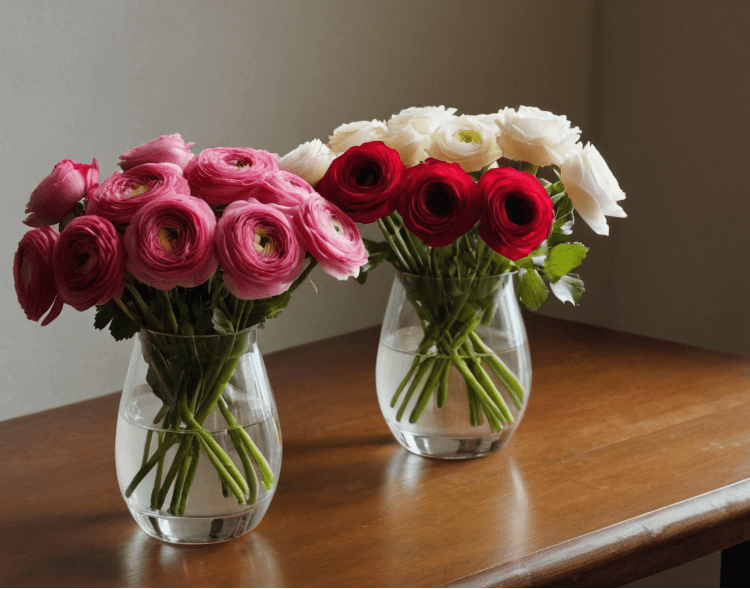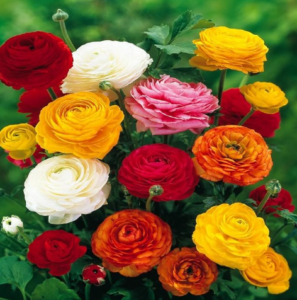
Ranunculus vs. Roses – it’s the floral face-off of the century! These beauties boast unique superpowers. Will the ranunculus’s whimsical layers outshine the rose’s timeless elegance? Let’s unveil the winner in this blossom battle royale.
Choosing between ranunculus and roses can be tough! Both flowers offer stunning aesthetics, but they have distinct characteristics. Here’s a quick breakdown to help you decide:
- Bloom: Ranunculus boasts a multi-layered, tissue-papery bloom, resembling a peony or a rose with looser petals. Roses come in a wider variety of shapes, from classic tightly-packed petals to open, garden-style blooms.
- Color: Ranunculus dazzles with a vibrant spectrum, including yellows, oranges, pinks, reds, purples, and even bi-colors. Roses, while offering a beautiful range, are generally known for their classic shades of red, pink, white, and yellow.
- Vase Life: Ranunculus typically lasts 5-7 days in a vase, while roses can endure 7-10 days with proper care.
- Seasonality: Ranunculus are generally available spring through early summer, while roses have a longer season, often blooming from spring through fall.
- Symbolism: Ranunculus traditionally represent charm, new beginnings, and cheerfulness. Roses hold a wider range of meanings depending on color, with red symbolizing love and passion, yellow for friendship and joy, and pink for appreciation and gratitude.
Key takeaways
Here are the key takeaways you’ll discover in this article:
- Ranunculus flowers come in a variety of types, each with its unique blooms and colors
- Planting Ranunculus bulbs requires selecting a sunny spot in your garden with well-draining soil
- Persian Buttercup, also known as Ranunculus, requires regular watering to keep the soil moist
- To ensure proper bloom, Ranunculus plants need at least 6-8 hours of sunlight per day
- Keep an eye out for common diseases that can affect your Buttercup plants, such as powdery mildew and crown rot
- Water Ranunculus plants consistently, keeping the soil evenly moist but not waterlogged
- Consider whether to propagate Ranunculus plants from seeds or by planting bulbs
- Troubleshoot and address any care issues promptly to keep your Ranunculus flowers thriving
Now, let’s dive into each of these topics in more detail.
Types of Ranunculus
1. Persian Ranunculus
- The most common variety with the classic, multi-layered blooms.
- Similar to the Persian ranunculus but with even more densely packed petals, creating a fluffy, pom-pom-like appearance.
3. Butterfly Ranunculus
- It boasts delicate petals that flutter slightly, resembling a butterfly in flight. These tend to have a more open, sprawling shape.
They are distinctive for their unique color combinations, often with speckled or picotee edging (where the outer petals have a contrasting rim of color).
5. Specialty Ranunculus
- This category includes a few newer and less common varieties, such as:
- Pon Pon Ranunculus: Offer very round, ball-shaped blooms.
- Clooney Ranunculus: Known for more prominent blooms and sturdier stems, a favorite of florists.
Important Note: Many ranunculus varieties are sold in mixed color palettes, ensuring a gorgeous bouquet without the need to pick specific cultivars.
6. Ranunculus Asiaticus
Origin: Ranunculus Asiaticus is native to the eastern Mediterranean region, southeastern Europe, and northeastern Africa. It’s one of the most popular ranunculus species for gardening and floral arrangements.

-
Appearance:
- Flower: The defining characteristic of Ranunculus Asiaticus is its multi-layered, densely packed blooms. They resemble roses or peonies with their delicate, tissue-paper-like petals.
- Foliage: The leaves are deeply lobed and fern-like, providing a lovely green backdrop for the showy blooms.
-
Colors: Ranunculus Asiaticus comes in a stunning array of vibrant colors:
- Yellows
- Oranges
- Pinks
- Reds
- Purples
- Whites
- Bicolors (with contrasting petal colors or edging)
-
Vase Life: With proper care, cut Ranunculus Asiaticus can last around a week in a vase.
-
Seasonality: They typically bloom from spring through early summer.
-
Cultivation & Uses: Ranunculus Asiaticus are both popular garden plants and a favorite in the cut flower industry, prized for their beauty in bouquets and arrangements.
Planting Ranunculus Bulbs
To grow magnificent Ranunculus flowers, proper planting is crucial. Before planting Ranunculus bulbs, select a sunny spot in your garden with well-draining soil. These flowers thrive in full sun, so finding the perfect location is essential.
Once you’ve chosen the spot, it’s time to dig a hole twice the bulb’s size. Place the bulb in the hole with the pointed end facing up. Cover the bulb with soil and water the area thoroughly. Following these planting steps ensures successful growth and vibrant blooms for your Ranunculus flowers.
What are ranunculus corms?
Ranunculus corms are the bulb-like structures from which ranunculus plants grow. They might not look like much at first glance! Corms resemble tiny, dried-out claws or maybe even spider legs.
How do they work?
- Corms store energy and nutrients that the plant needs to sprout and produce those beautiful blooms.
- When planted, they develop roots and send up shoots that eventually become the ranunculus plant’s stems, leaves, and flowers.
Key points about ranunculus corms:
- Size matters: Larger corms generally produce healthier plants with more flowers.
- Orientation: Plant them with the “claws” pointing downwards. That’s where the roots will grow.
- Pre-soaking: Some gardeners soak their corms in lukewarm water for a few hours before planting to give them a head start.
Where to find ranunculus corms:
- Garden centers and nurseries: During the spring planting season.
- Online retailers specializing in bulbs and corms Offer a broader selection of varieties year-round.
Persian Buttercup Care Tips
Persian Buttercup, or Ranunculus, requires regular care to thrive and produce stunning blooms. One of the crucial care tips is to provide consistent watering to keep the soil moist. Additionally, adding a layer of mulch around the plants can help retain moisture and suppress weeds.
It is important to deadhead faded blooms to encourage continuous blooming throughout the season. These care tips, including regular watering, mulching, and deadheading, will help keep your Persian Buttercup plants healthy and thriving all season long.
Ensuring Proper Bloom
Several factors come into play to achieve a stunning bloom display with your Ranunculus flowers. First and foremost, ensure your plants receive at least 6-8 hours of sunlight daily. Sunlight is essential for the proper growth and development of these flowers. Applying a balanced fertilizer every 4-6 weeks can promote healthy growth and abundant blooms.
If you notice any leggy or tall stems, don’t hesitate to pinch them back. This will encourage a compact and bushier plant, producing more impressive blooms. By following these steps, you can ensure your Ranunculus flowers reach their full blooming potential.
Common Buttercup Plant Diseases
Like any plant, Ranunculus flowers are susceptible to certain diseases. Two common diseases to watch out for are powdery mildew and crown rot. To prevent these diseases, adequate air circulation and spacing between plants must be provided. This will help minimize the chances of the diseases spreading.
If you notice any signs of disease, treating them promptly with appropriate fungicides is crucial. By staying vigilant and aware of these common diseases, you can protect your Ranunculus flowers from potential harm and ensure their health and beauty.
Watering and Feeding Ranunculus Plants
Proper watering and feeding are vital for the health and vitality of your Ranunculus plants. These beautiful flowers require consistent watering, keeping the soil evenly moist but not soggy. This ensures they receive the hydration they need without becoming susceptible to issues like root rot. In addition to watering, applying a slow-release fertilizer in early spring and again in midsummer is essential.
This will provide the necessary nutrients for optimal plant growth and vibrant blooms. By monitoring the soil moisture and adjusting watering accordingly, you can ensure your Ranunculus plants thrive.
Seed Propagation vs. Bulb Planting
When growing Ranunculus plants, you have two options: seed propagation or bulb planting. Seed propagation allows for more variety, as you can experiment with different types and colors. However, it requires more time and effort, as the seeds need to be planted and nurtured until they mature into plants.
On the other hand, bulb planting offers quicker and more reliable results. This method is particularly beneficial for beginner gardeners who want to enjoy stunning blooms without extensive waiting periods. It is essential to consider the pros and cons of each method to decide which one suits your gardening preferences.
Troubleshooting Ranunculus Care Issues
While growing Ranunculus flowers is a rewarding experience, there may be times when you encounter care issues. If your plants are not blooming, ensure they receive enough sunlight and nutrients. Lack of the sun or inadequate nutrients can stunt the growth and blooming. Additionally, keep an eye on the leaves.
Yellowing leaves may indicate overwatering, while wilting leaves may signal underwatering. Pest infestations can also hinder the health of your plants. In such cases, organic insecticides or attracting beneficial insects can help control the infestation. You can promptly troubleshoot and address care issues to ensure your Ranunculus flowers continue to thrive.
In conclusion, growing stunning Ranunculus flowers requires attention to detail and proper care. By choosing the suitable types of Ranunculus, planting bulbs correctly, providing adequate care, ensuring proper bloom, and troubleshooting care issues promptly, you can enjoy a garden filled with these captivating flowers. So why wait? Unlock the secrets to growing stunning Ranunculus flowers and create a garden that will leave everyone in awe.
Frequently Asked Questions
Do ranunculus like sun or shade?
Ranunculus flowers thrive in full sun to partial shade. It’s best to plant them where they can receive at least six hours of sunlight each day to ensure they grow and bloom beautifully.
How poisonous are ranunculus?
Ranunculus plants contain toxic compounds that can be harmful if ingested. It’s important to handle them with care and keep them away from children and pets. While they may not be deadly, they can cause skin irritation and gastrointestinal issues if consumed.
Do ranunculus bulbs multiply?
Yes, ranunculus bulbs can multiply and produce more bulbs over time. By allowing the bulbs to remain in the ground after flowering and providing proper care, you can encourage them to multiply and create a more prominent display of stunning blooms in your garden.
How long do ranunculus bulbs last?
Ranunculus bulbs can last for multiple growing seasons if adequately cared for and stored correctly during their dormant period. With proper maintenance and attention to their needs, you can enjoy the beauty of ranunculus flowers year after year in your garden.

























